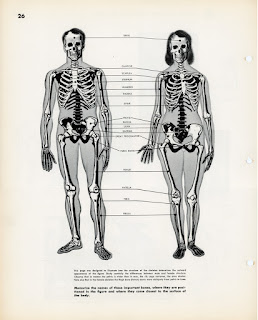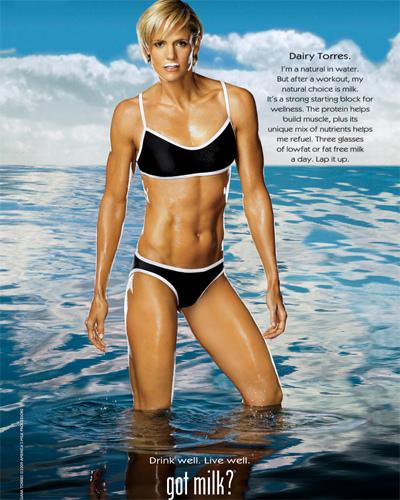When you open any book on anatomy, they'll usually start with a really basic fact that's helpful in trying to make figures look either masculine or feminine: the male body usually has wider shoulders and relatively narrow hips, while female figures have wider hips than men, with comparatively narrow shoulders.
There are a few reasons for this; women tend to have bigger hips, for one, because the female pelvis is wider than the male pelvis. This is because women, in order to give birth, have to pass a baby through their pelvic bone.
Also, women tend to store fat on their hips, thighs and rear ends, but not around their waists. Even as they develop after puberty and their hips widen, their waists stay about the same as before puberty (at least according to this wikipedia article on Female Body Shape). So females tend to have thinner waists than hips, giving them that hourglass shape.
Why do women tend to collect fat in that area? I think I've read that women's bodies do that to protect the uterus and keep it warm, which aids in growing babies...but someone correct me if I'm wrong.
The female body shape changes after menopause. As women get older, they begin retaining fat in their waist area, and eventually, abdomen (again, see the wikipedia article). I suppose this is why it always seems to me that, the older women and men get, the more the physical differences between the sexes are harder to see.
The reason that men have wider shoulders than women, as far as I know, is because the male ribcage expands during puberty to accommodate the lungs, which also expand in males during puberty. Males, being larger than females, need larger lungs to supply their bigger bodies with enough oxygen.
Unlike women who collect fat in the thighs, hips and rear end, men tend to collect fat in the stomach area.
One important thing to always remember is that, even when the body shape of a person changes due to adding muscle or gaining weight, the shape and size of the ribs and pelvis stay the same. Obviously, bones don't gain muscle or weight. So no matter how muscular or overweight a person is, the underlying skeleton remains unchanged.
So all these factors are useful when trying to draw and design male and female characters and trying to retain their feminine and masculine traits. That can be hard to do, especially as they deviate from the ideal, and as you try to make them heavier or older.
But what about the exceptions? Obviously, these "rules" aren't absolute. Like any rule, once you understand it you can break it and subvert it when it makes sense to do so.
The first exception that springs to mind is female swimmers.
Female swimmers tend to have broader shoulders and narrower (by comparison) hips.
Obviously, all female swimmers weren't magically born this way. The ribs and pelvis of a female swimmer are exactly the same size as those of their everyday counterparts (that is, women who don't swim competitively).
The reason female swimmers look the way they do is because they work out to increase the size of their shoulder muscles (so their shoulders get bigger), and they have very little body fat (since women collect fat in their hips, and a fit female swimmer has very little fat, there's none to expand the size of the hips).
Finding men with hips that are bigger than their shoulders is a bit harder, but it does happen. It's interesting how each individual body distributes weight in a different distinctive way. Some men seem to gain weight and still preserve the typically male narrow hips, so that they retain the male standard of broad shoulders and narrower hips...
...and some don't. Sometimes you do see men who have wider hips than shoulders. Milt Kahl used this concept for Mr. Snoops in "The Rescuers", and, in that particular case, it lends a soft, bumbling, ineffective feel to the design that fits his personality.
But that's not the only way to use that idea.
Anyway, this isn't meant to be an exhaustive look at how many variations there are to male and female body types - the possibilities are endless. Look around and see how many you can find.
The point is, use the standards of what we expect from the male and female body and stick to the ideals when it helps you. Play against the expected body types when that helps you, as well. Once you know why our bodies look the way they do, you can change around anatomy to your heart's content to achieve whatever effect you want to achieve.
When you're designing your characters, always think about who that character is and what type of personality they have, and how you can reflect that personality in the body that you give them.
DIGITAL JUICE









No comments:
Post a Comment
Thank's!